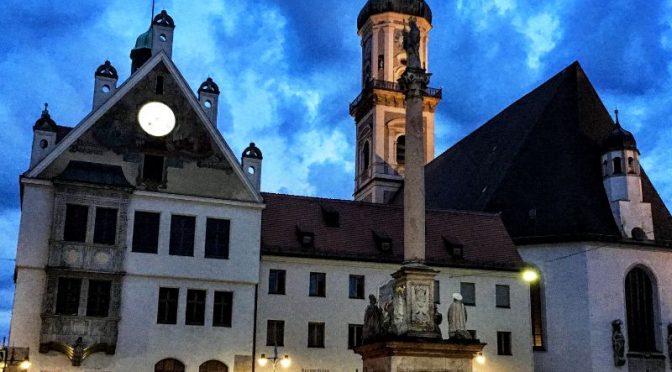Freising is a town of 50,000 people located along a main train route about 20 miles northeast of the center of Munich. Freising is also the closest town to Munich’s airport and is often thought of as the location of the airport. On my last visit to Munich, I decided to spend a few days winding down there in advance of my flight home. It’s a great place to base out of if you have an early morning flight due to the frequent bus schedule and a short 15-minute trip duration.
Note: We know COVID-19 is impacting travel plans right now. For a little inspiration, we’ll continue to share stories from our favorite places around the world so you can keep daydreaming about your next adventure.
Make no doubt though, Freising is far more than a convenient travel stop. Built on two hills that tower above the Isar River, the area has been inhabited for more than 4000 years. Freising is said to be the oldest community in the south of Bavaria and has been an important religious and cultural center for the region since the eighth century when the Weihenstephan Benedictine monastery was established on one of the hills. A church dedicated to the Virgin Mary was established on the other. The man behind these developments was a French bishop named Korbinian, who was sent by the pope to Christianize Bavaria (Bavaria was ruled at that time by a Duke who was also French.)
St. Korbinian figures heavily into local legend and lore to this day. The miracle of the bear recounts the story of Korbinian encountering and being attacked by a bear while on a journey to Rome. His horse was killed by the bear so Korbinian somehow convinced the bear to let him strap his saddlebags and the bear served as his pack animal for the rest of the trip. Today, the image of a bear appears together with St. Korbinian on Freising’s crest and is a very visible town mascot. Whimsically painted bears crop up all over town.
For beer lovers, Freising is also notable as the location of the oldest continually operating brewery in the world. The Weihenstephan monastery began brewing beer in the dark ages and was eventually licensed to produce beer in 1040, the founding date claimed by the modern brewery. The monastery was secularized in 1803 and since then the brewery has been owned and operated by the State of Bavaria. The brewery is still on the grounds of the old monastery and is now surrounded by a small university specializing in, among other things, brewing and brewery technology. Freising is also the seat of the region encompassing the Hallertau, one of the most important hops growing regions in the world. Read about my visit to the Hallertau.
For beer hikers, there is an excellent loop hike that tours the countryside north of town and passes a country beer garden and the Weihenstephan Brewery and biergarten. You can read about and get route information about this hike here.
Fresising Breweries
Visiting Weihenstephan Brewery in Freising sure feels like entering hallowed ground. Visits are well organized and are hosted by advanced students of the Technical University of Munich’s (TUM) Weihenstephan brewing technology programs. My guide, Phillip, told me that there are two tracks in the University’s programs there in Freising. He is part of a cohort of about 80 students who gain a broad range of knowledge in brewing technology that gives them experience not only with brewing, but with the full range of technologies that go into the process including ingredients, equipment, and distribution. Another cohort is more focused on becoming master brewers.
Weihenstephan has the feel of a very modern operation in a very old set of buildings. It is boggling to consider that they have been brewing non-stop on top of this hill through multiple wars, four fires, three plagues, a major earthquake over nearly a thousand years. The output of about 200,000 bbl per year (within the U.S. definition of a craft brewery) is spread across 12 varieties of beer with the flagship being their hefweizen. There is a beer shop, restaurant, and beer garden on site.
Hofbrauhaus Freising is also a very old enterprise dating back to 1160. Located on Freising’s other hill, it is a beautiful old brewery building on a busy street. On a bluff above and behind the brewery building is one of the brewery’s four kellers, or beer gardens. For my sensibilities, this is the best and most classic beer garden in Freising (read about what makes a great beer garden here). As much as I enjoyed the visit at Weihenstephan, I found that I greatly enjoyed the beers, food, and atmosphere found at Hofbrauhaus Keller. Yes … I am a sucker for a massive and tasty schnitzel!
An interesting part of the Hofbrauhaus Freising line-up are beers marketed under the Dirndl Brau brand. Dirndl Brau beers are the creation of the brewery’s female brewing staff. I tried the Schürzenjäger India Pale Lager (IPL), a nicely hoppy lager.
You may click on any gallery image to see it in a larger format and to open a slideshow viewer that lets you scroll through larger versions of all images.
Beautiful Freising
Freising is a picturesque town with many urban pathways connecting the two hills. The cathedral is a twelfth century, Romanesque gem that spans from Gothic to Baroque architectural eras. I was lucky to be visiting in mid-September during the Freising Volksfest an enjoyable small-town celebration that has been held annually for 90 years.
For more stories about hikes and beers in Germany, CLICK THIS LINK.




















































































Leave a Reply